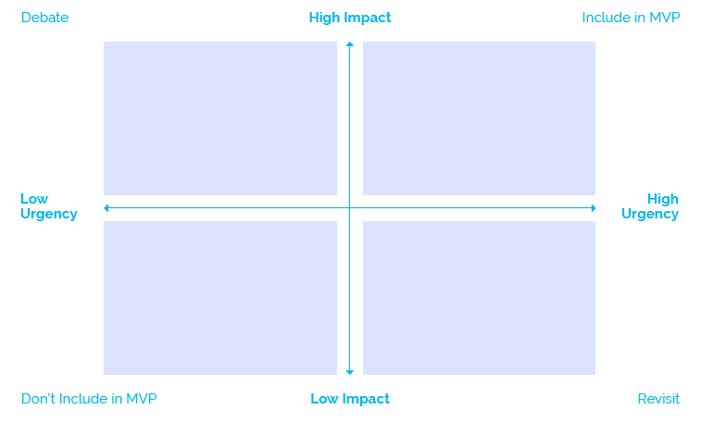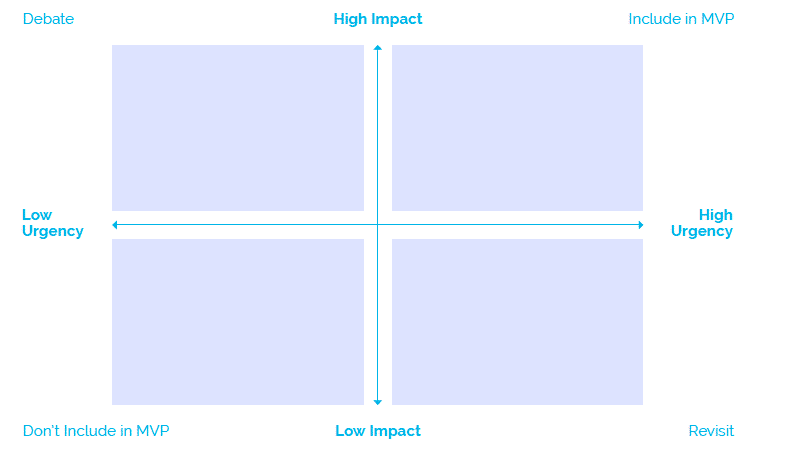Lean Startup author Eric Ries gives a commonly accepted MVP definition, describing “a version of a new product which allows a team to collect the maximum amount of validated learnings about customers with the least effort.” In mobile app development, your minimum viable product includes the feature or features required to solve a core problem for a set of users and be released to market.
A central tenet of lean methodology, MVP development follows a build-measure-learn process; the goal is to provide immediate value quickly while minimizing development costs and using data to learn what users want and need. The lean startup MVP method helps you to release a product that can be continually improved as you validate (or invalidate) assumptions, learn what users actually want, and build future iterations of your app that better serve your customers. The goal is to provide immediate value, quickly, while minimizing development costs.
What is the Purpose of an MVP?
As mentioned above, the main goal of an MVP is to provide a working product that serves a core function for a set of users. An MVP is also used to gain user feedback and to showcase business potential.
Starting with an MVP will provide a rich learning experience, which will allow you to learn more about your end-user and the market you wish to enter. An MVP will set the stage for future iterations of development and clarify the successive steps to take in the project – whether that’s changing directions entirely or continuing down your set development path.
This step-by-step guide will provide all the steps you need to plan your minimum viable product and start development.
TL;DR: Planning Your Minimum Viable Product
1. Identify and Understand The Business Needs
a) Determine the long-term goal of the product and write it down
b) Answer the question, “Why are we doing this project?”
c) Identify the success criteria that will indicate whether or not the product is successful
2. Find The Opportunities
a) Map out the user journey(s)
Identify the users (actors)
Identify the story ending (end goal)
Identify all actions user must take to meet that end goal
b) Create a “pain and gain” map for each action
Write down the action the user completes when using the product
Write down the pain points for each action
Write down the gains for each action
c) Summarize the pains and gains into opportunity statements
Use “How might we” statements or a similar method to summarize the pains and gains you have identified
3. Decide What Features To Build
a) Use opportunity statements to finalize your features
b) Provide a breakdown of the features to include in the product roadmap
c) Use a prioritization matrix (or similar method) to prioritize features
The Long Version: Building Your MVP Development Framework
We have grouped the planning process of a minimum viable product into three simple yet valuable steps, the short versions of which are listed above. We will now provide a step-by-step process with more detail and context so you can easily apply this framework to your project. This process is part of the agile MVP development framework we use at Voila Hub for our mobile app development projects.
Every step mentioned should be part of product definition for any project, however following these steps will help you identify and prioritize features in a manner that allows you to confidently outline what you need in order to get your minimum viable product to market.
1. Identify and Understand The Business Needs
At the very beginning, you should have identified a need as to why the product should exist. This could be an organizational need or a customer need that addresses a current gap.
a) Determine the long-term goal and write it down. You want to answer a simple question: Why are we doing this project? A coffee shop chain, for example, may have the long-term goal of reducing time-to-checkout by 30%.
b) Identify success criteria. Next, identify the criteria that will determine whether or not the product will be successful. This will likely – and probably should – consist of more than one metric. Our coffee chain, for example, might define success by reaching that 30% time-to-checkout reduction, having 100,000 active monthly users, and reaching $1 million in monthly transactions via their app.
2. Find The Opportunities
In the first stage of planning your minimum viable product, you should have already identified market gaps or identified a problem that needs to be solved, whether for your company or for consumers. The next stage of MVP development consists of finding the opportunities to solve these problems and add value via your app.
a) Map out the user journey(s). The user journey is most easily divided into three parts: the user, user actions, and story endings.
i. Identify the user(s). These are the people who will be using your product. It’s possible that you will have more than one category of user. For example, if you have a service appointment booking app, you may have both the appointment scheduler (customer), and the service technician.
ii. Identify the story endings. For each user, there will be a story ending, which is the end goal of the user.
iii. Identify the jobs (actions). The jobs are the actions that the user or users need to take in order to reach the story ending and achieve the goal.
We suggest creating a chart to map out the user journeys. Below is an example of how this might look for a Pet Adoption Agency app.

When planning your minimum viable product, you will likely want to look at which user has the most jobs and focus on that user (this will allow you to stay true to the lean startup MVP methodology – adding the most value quickly, with the least amount of effort). In the majority of cases this will make the most sense; however, there may be higher priorities that need to be addressed, so you may need to focus on a different user.
b) Create a Pain and Gain map for each action. The pain and gain map allows you to identify all user pain points and the gains the user achieves when each is addressed. This exercise lets you determine where you have the greatest potential to add value. You are then able to focus your minimum viable product in these areas while adding the less impactful ones to the product roadmap for future releases.
i) Write down the actions the user needs to complete. List the actions that you identified when mapping out the user journeys.
ii) Write down the pain points for each action. The pain points are brief summaries of the problems or inconveniences that users have when trying to complete that action.
iii) Write down the gain for each action. The gain is what the value-add achieved when that pain is addressed.
List and count the number of pains and gains for each action, for each user. Ideally, when it makes sense, you should assign a value using a point system to help quantify the importance or impact of the gain. We recommend organizing the pain and gain map into a chart. If we revisit our Pet Adoption Agency example, here is what a pain and gain row in our chart might look like for the Pet Adopter user.

c) Summarize the pains and gains into opportunity statements. There are a number of ways to summarize pains and gains. One is to use opportunity statements that follow a “How Might We” format. For example, “How might we make it easier for users to book appointments?” This helps you translate the pains and gains you identified in the previous step into feature sentences (more on this below).
3. Decide What Features to Build
In this stage, you will be able to discern what features to include in your minimum viable product, as well as the features to include on the product roadmap that are a lower priority.
a) Use opportunity statements to finalize your features. Using your opportunity statements from the previous step, finalize what features you want to build out. At this stage in the MVP development process, you will want to create feature sentences. For our Pet Adopters that are applying to adopt animals, for example, the opportunity statement “How might we expedite the application process?” could become “Reduce application processing time by 10%.”
b) Provide a breakdown of the features to include in the product roadmap. List the user and the specific opportunity statements, and provide a breakdown of the features to include in the product roadmap.
c) Use a prioritization matrix (or similar method) to prioritize features. This step helps you identify where you can make the most impact with your product in relation to the urgency of the feature. Using a prioritization matrix, you can make the final decision on what absolutely needs to be included in your minimum viable product, and what features can be included in later releases. Below is our recommended format for your MVP prioritization matrix.

Your MVP Development Framework is Set!
At this point, you should have a strong foundation to get started with developing your minimum viable product. You have identified and understand your business or customer needs; you have found the opportunities to address the pain points, and you have decided what features to build and their priority. Agile MVP development allows you to focus on these features for the initial build, collect data and learnings, and iterate and improve based on your learnings. Now, you can focus on getting your MVP to market.
Why Start With an MVP?
Test Assumptions and Build a Business Case
The core benefit of an MVP is the ability to create new ideas and test assumptions. An operational MVP allows you to take a version of your product to market to test your initial assumptions. In the process, you will generate new ideas grounded in user behavior research which will shape the subsequent versions of your product.
An MVP lets you test your business concept early before you commit to a feature-heavy product. You can take your product to market quickly and cut costs in the long run.
Win Stakeholder Buy-in
MVPs are critical for seeking funding from stakeholders. Whether you’re looking for support from internal or external investors, an MVP definitely strengthens your position. You cannot go to potential stakeholders with a first-stage plan; investors require an established business case and an operational application that demonstrates the market validity and showcases growth potential. With an MVP, you can prove the merit of your product and secure funding for future development.
An Iterative Process Builds Value Over Time
With an MVP, you’re going to market with only core functionality and as your product evolves, you can learn from your growing user base. Insight from user data allows your product team to make research-based decisions about each stage of development, including what features to prioritize, how to improve ROI, and exactly where to allocate budget.
Cost Efficient
Mature, feature-rich apps are a result of years of development and have a cost to match; however, MVPs are built iteratively allowing costs to be spread over time. Typically, the budget for further development is a reinvestment of revenue generated from earlier versions of the MVP. Building an MVP allows you to drive the highest value for your business while dramatically minimizing the cost.
Mitigate Risk
When you start development with an MVP you’re making risk easier to manage by investing a small amount of money to test the market. This strategy also affords you room to react quickly to unexpected changes based on customer and market research.
What Features to Avoid in an MVP
Cool Add-ons
These features can be defined as features that serve only an aesthetic purpose. They don’t actually add value to the MVP. An example would be a social media integration, which is a nice to have but makes more sense to add in the later stages of development.
Copycat Features
Copying every feature your competitor has in your MVP is most definitely not recommended. When you try to add as many features as a more established app, you’re adding scope to the project which subsequently affects the timeline and budget. The purpose is to develop an MVP that aligns with your business goals.
Features Requested By Early Users
Even though user feedback shapes each stage of your application, you should still proceed with caution. Implementing user-requested features should be based on thorough research and analysis over time. Adding everything right away can harm the user experience.
What Features to Include in an MVP
Determining what features to include in an MVP is a difficult process. Keep in mind, the main features to include in an MVP are only the features that are connected to its overall goal.
You and your development partner will work together to create a very detailed workflow to represent your MVP and prioritize only the features needed to take your product to market.
If you are searching for a mobile app development partner to help build your MVP, contact us today.




